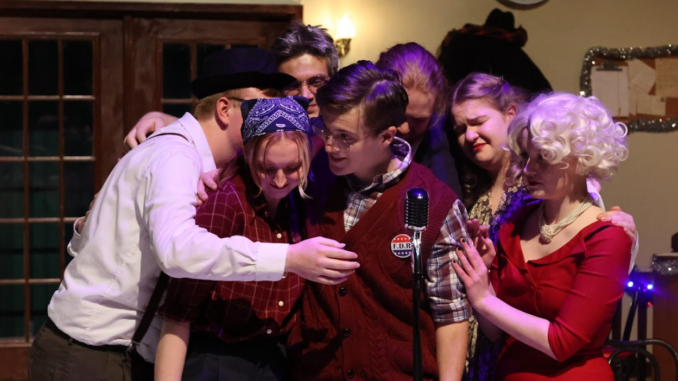
Maxwell Marcello | Staff Writer
From Muppets to Mickey Mouse, vampires to Barbie — the Charles Dickens’ tale, “A Christmas Carol,” published in 1843, has transcended eras, being adapted countless times over.
One of the lesser known adaptations is currently in production on Duquesne’s campus as the Red Masquers put on “A 1940s Radio Christmas Carol,” set on Christmas Eve in the titular era.
However, just as the show was about to start, I began to ponder: Could the Red Masquers showcase a performance of a story that we’ve all seen every holiday season, but in a new and creative direction? The answer is a resounding yes.
“A 1940s Radio Christmas Carol” first diverges from the traditional Victorian England setting, instead unfolding within the Aberdeen Hotel in New Jersey at the height of WWII. The set designers adeptly captured the era’s essence, delivering an authentic portrayal that left me genuinely impressed.
Their meticulous attention to detail in crafting a stage by blending the style of 1940s broadcast with an ordinary housing interior was particularly impressive. The drama boldly blend different popular forms and styles of media at the time, incorporating elements from musical theater, radio shows and wartime propaganda.
War looms over the broadcast heavily and influences the show’s progression, frequently referenced throughout. Characters often make asides, urging the audience to buy bonds, mirroring the real-life integration of such promotional messages of the time.
With the setting established, host Clifton Feddington, portrayed by Dante Martin, establishes the meta premise of the show: “A 1940s Radio Christmas Carol’’ is a rendition of “A Christmas Carol,” presented as a performance faithful to the storyline within a holiday radio broadcast.
Once the broadcast starts rolling, Scrooge, who is played by in-universe famous actor, William St. Claire (and portrayed by Alex Hladio), takes center stage, and the story begins.
At this point I expected the plot progression of “A Christmas Carol” to commence and the drama to go on autopilot. However, the performance deviated from my expectations in two ways: the interpersonal drama between characters slowly building over the course of the broadcast and the structure itself.
Efforts were made to be as accurate to the stylings of radio programs of the era as they could. The aforementioned disruption in the narrative does not just apply exclusively to government bonds, but for a variety of causes.
At times, major points in plot progression were interrupted by the actors who then transitioned into advertisers selling products ranging from lingerie to cigarettes then back to journalists giving updates from the ongoing war. Indeed, it truly was a dark and horrible time before skippable ads. Unintentional intentional interruptions were also interjected to give the studio an authentic hole-in-the wall feel.
In addition to advertising breaks, the broadcast would shift from the telling of “A Christmas Carol” toward musical theater featuring original compositions.
Shifting between diverse characters poses a significant challenge for actors. Nevertheless, the casting executed an exceptional job in meeting the demands of every role. Whether it was seamlessly transitioning into impromptu musical performances or authentically conveying the necessary emotional shifts woven into Dickens’ original work, the cast delivered.
Although I did notice some accents disappearing, it did not hinder my overall enjoyment of the production. Each and every cast member truly became their on-stage characters, down to the often overlooked mannerisms such as the fidgeting for the anxious character or the total lack of awareness for the comic relief.
Special recognition is due to Hladio for his remarkable versatility and commanding portrayal in the pivotal role as a lead character. Another noteworthy performance fell to Martin whose portrayal can best be described as being modeled off of Walter Winchell.
“A 1940s Radio Christmas Carol” achieves the impossible by creatively reimagining the familiar Victorian Era tale, adapting it into an uncharted setting while maintaining a balance between innovation and loyalty to the original source material.
For an authentic radio experience, I suggest occasionally closing your eyes – though not always – lest you miss the meticulously crafted period setting, endearingly quirky sound effects, and the subtle yet significant character transformations. This immersive journey into the world of vintage radio promises a delightful blend of nostalgia and artistry that shouldn’t be missed.
You can see “A 1940s Radio Christmas Carol” at the Genesius Theater from Dec. 6 to 9. Tickets are $5 for students, $10 for seniors and $20 for general admission. Purchases can be online through the Red Masquers’ website, https://www.duqredmasquers.com/.

